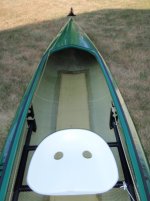Hung up.. Something is sticking in the rudder track. OEM rudder track.. It must be sand and grit or something. The track has been lubed. Its all black and ooky. What to clean it with and does it need relubing?
It kept hanging up mostly on one side in strong seas on Newman Bay in Newfoundland which made an interesting trip.
If you get a definitive, or even agreed upon, answer on rudder track lubricant please let me know
One thing I do know is that blasting the tracks with a hose jet spray while moving the slider rails back and forth is the place to start. Whatever grit, sand, shell shard, debris is in there needs to come out before lubrication the slide. Black and ooky doesn’t sound good.
One thing I believe helps in a preventative way is to sponge any water (and grit) out of the hull before flipping it upside down on the roof racks (or in camp), so that the residual water isn’t carry the dirt, sand and debris from the bottom onto the tracks. I am no angel at that, especially at the tired wanna-get-going end of a trip when I often just heave a boat on the racks and get a bilgewater dousing. Attesting to that I have boats on my storage racks with sand aplenty still adhered inside.
I know that when I jet blast the gunwales on my open canoes the amount of crud that sometimes shoots out is between amazing and disgusting, and that track slider is just as likely a dirt trap.
One thing (among many) I do not know is the most effective lubricant. I have used a variety of products, with varying degrees of success.
WD40. OK, I don’t use that. I mentioned it only because I think WD40 is near useless in most applications, and it is definitely sand attractive. The only thing WD40 has going for it is advertising and universal availability.
Silicon spray. Works well enough, at least at first, but the slipperiness doesn’t last long and if it is too freshly/thickly applied it will collect sand. Add to that I am leery of the aerosolized overspray getting into anything I might need to repair.
Armor All. A product I dislike for almost every other application, because I know it makes stuff slipperier than snot on a door knob. My Armor All sprayer dispenses milk-like splatters, so I have sprayed it on a cloth and cleaned/lubed the tracks with that.
Armor all seems to provide pretty good, lasting glide, and less sand attraction than silicon spray. That may be attributed to having heavily sprayed the tracks with silicon vs wiped them down with Armor All. A lighter coat may be better. 303 might work as well or better.
The most sensible recommendation I have read is to use a dry lubricant, and there are dozens of those from bike chain products to auto brake parts stuff.
Googling “rudder pedal lubricant” is not recommended unless you have an hour, two beers and a sense of humor about suggestions to use everything from candle wax to WD40 to nose oil. Some of the wet lubricants, especially the petroleum-based stuff, is questionably for long term use on plastics.
There is no consensus to be found there, but this stuff seems like the best dry spray candidate. Teflon Non-stick dry-spray lubricant:
http://store.tmcindustries.com/DuPo...z_p_145.html?gclid=CLq0vaOy5ccCFYEYHwodgtIBFA
I couldn’t find it available in the usual Home Depot/Lowes/True Value vendors so I ordered a can on-line.
A couple of the decked boats have freshly lubed pedals, and a couple yet need some cleaning and attention. I’m thinking a dry lubricant would best go on a non-oily surface, so after blasting and cleaning the pedals in those boats will get Teflon Spray.
Kim, I am not a big fan of that OEM rudder pedal track and slider. Beyond the non-adjustability of the pedal length of that kinda crude 30 year old design of tracks and slider rails seems unnecessarily long, and their position, with vertical pedals hanging down from the cowling/deck, seems ideally located to capture dirt and sand left in a wet hull.

